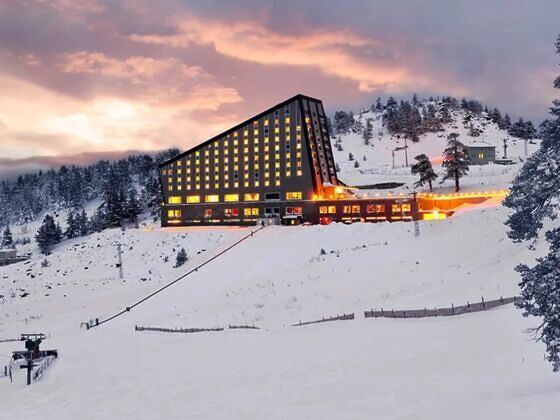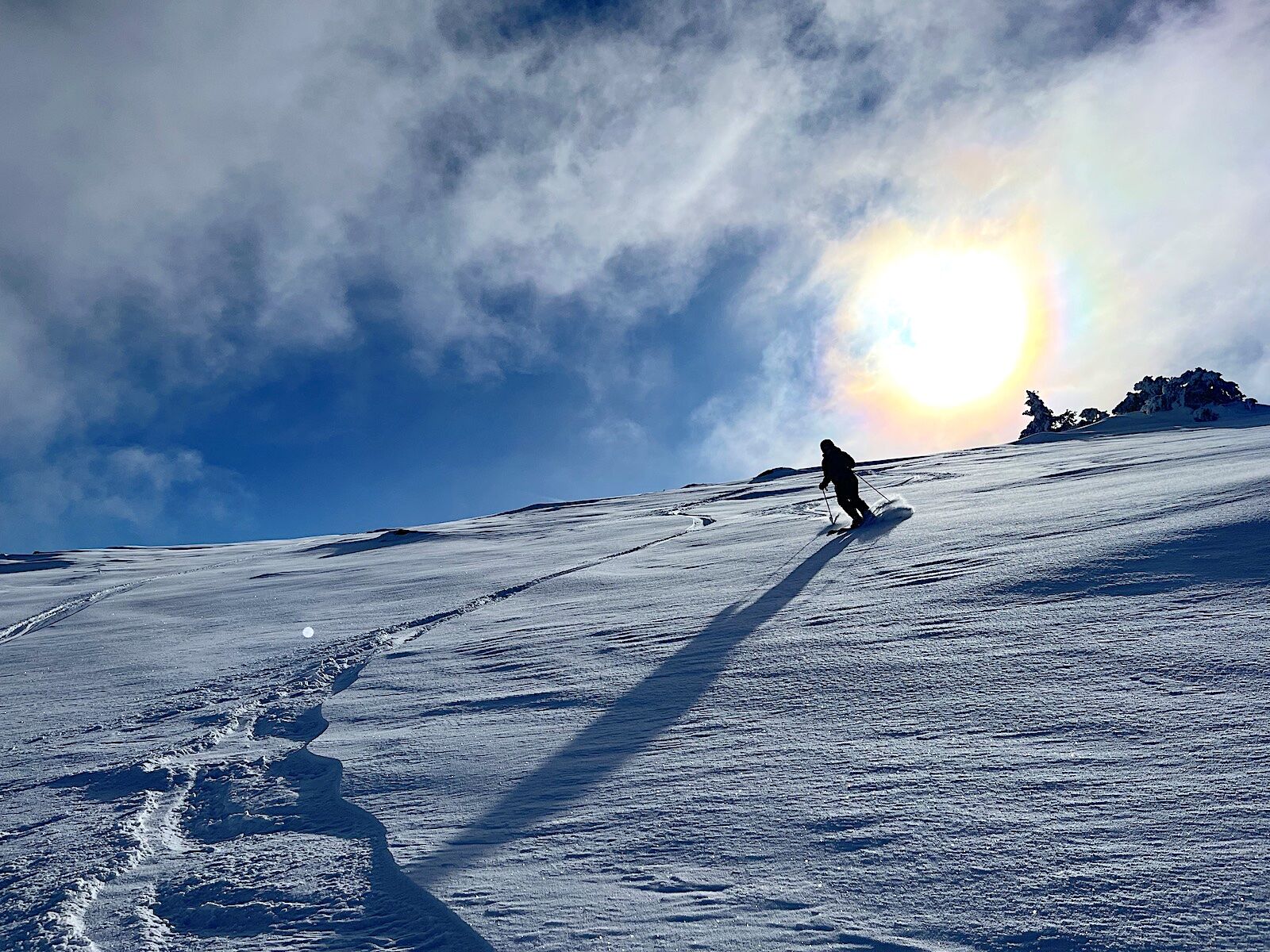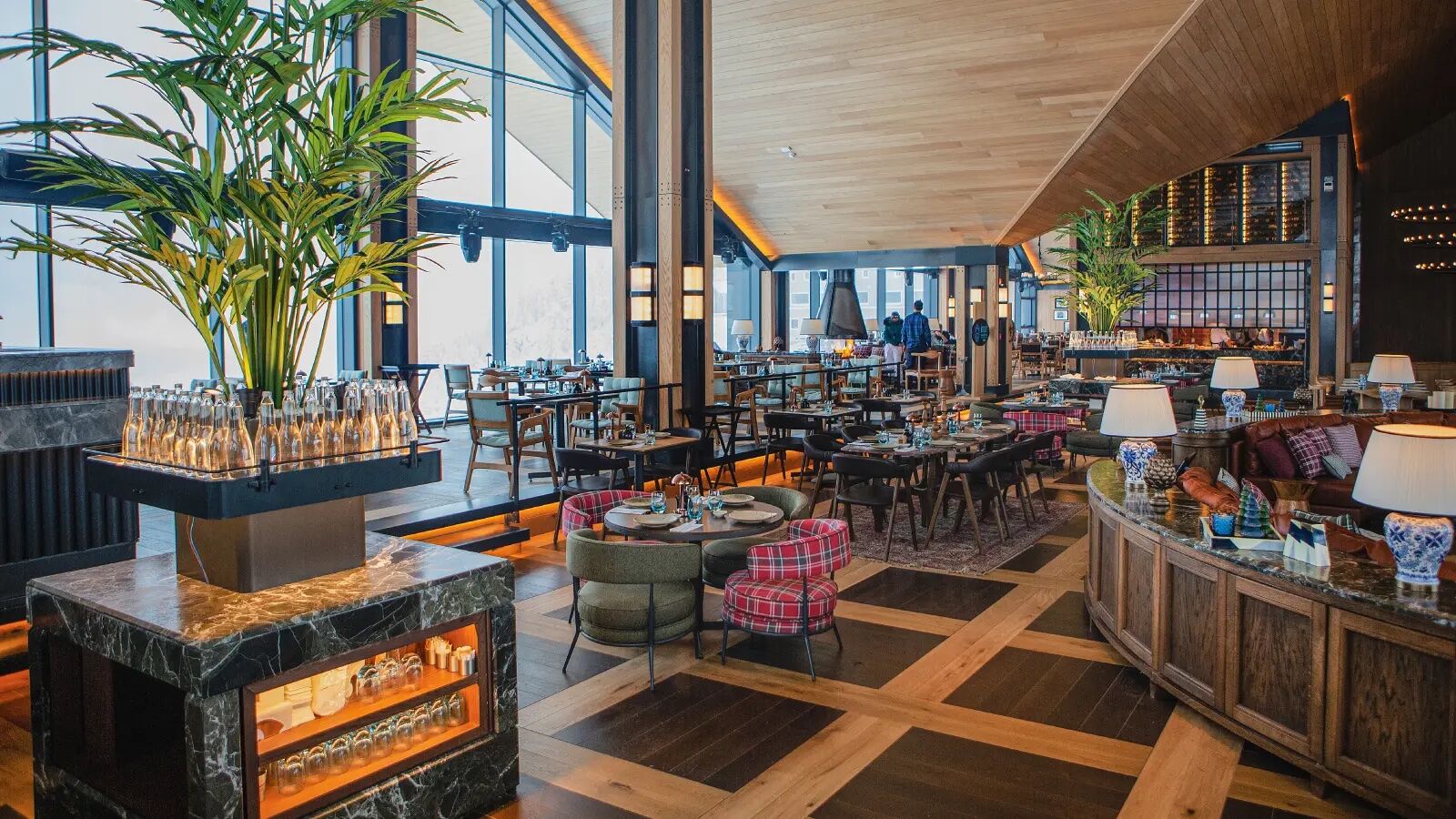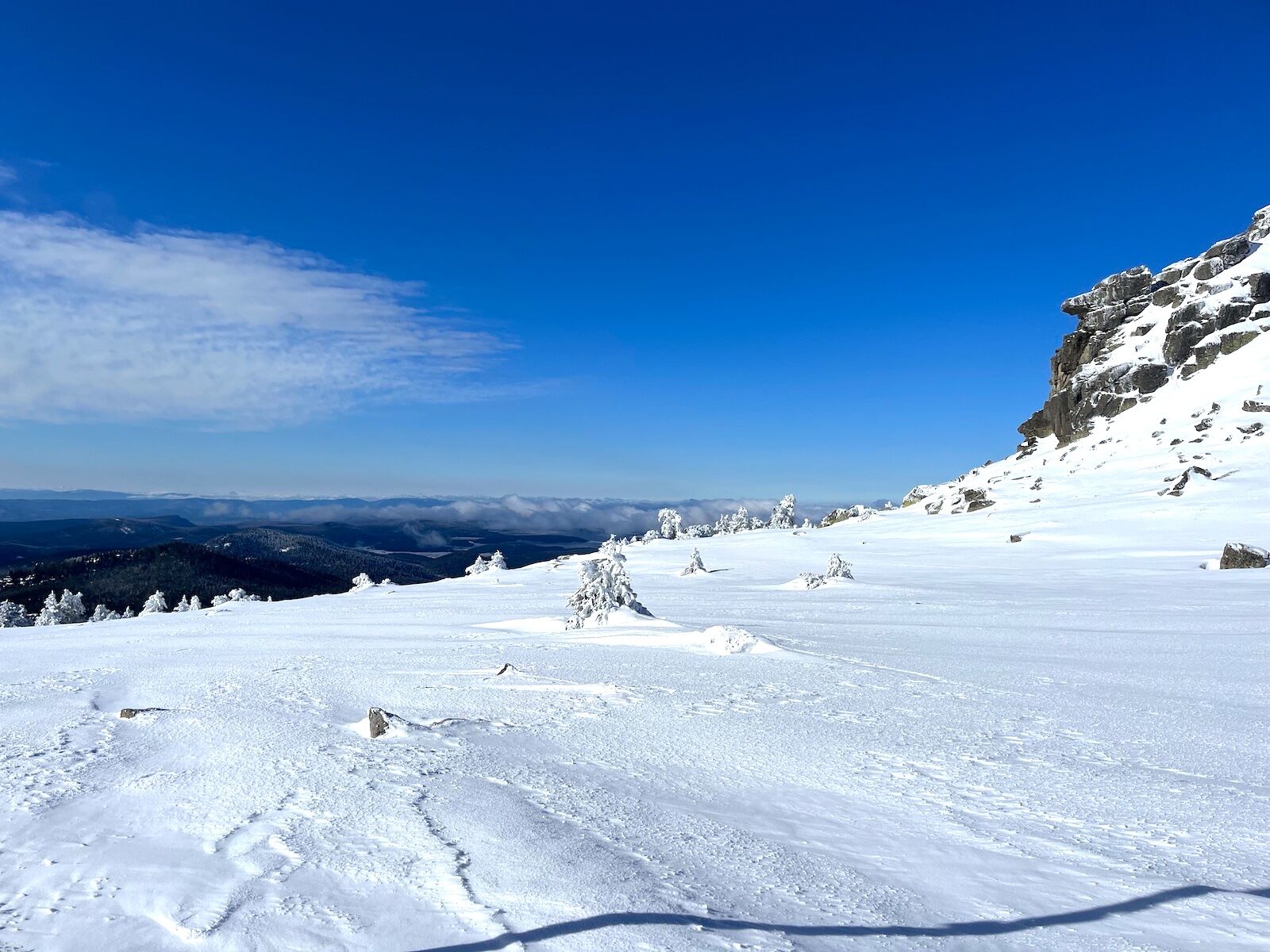Modern lore has it that it was in Michigan, circa 1965, when “father of the snowboard” Sherman Potten first carved a board out of wood hoping to bring the feel of surfing to the mountains. However, according to some historians (including pro snowboarder Alex Yoder), modern lore is wrong. To trace the roots of snowboarding, they say, one must head not to Vermont or Michigan, but to Türkiye, where, some 300 years ago, residents of the village of Petran in the foothills of the country’s Kaçkar Mountains first fashioned a rope to the nose of a hefty wooden plank lubed with cow fat and pointed it down a hill. A few modifications and a couple of extra nails in the hull later, the sport this writer loves so dearly was born.

Finding Pristine Slopes in Türkiye, the Birthplace of Snowboarding
I’m a native Coloradan who has effectively built his life around snowboarding. I applied to and attended university in a small mountain town not because of the job-landing credentials of a liberal arts education, but solely because I could participate in this activity almost daily. Over the years I’ve embarked on snowboard expeditions to places as far away as Kyrgyzstan, northern British Columbia, and throughout the United States. In the interest of being thorough, I felt I needed to trace the sport back to its Turkish roots. At least, as close as I could get. This desire is what in February led me to join a group of vagabond North American journalists checking into Kaya Palazzo Ski & Mountain Resort, a chalet-hotel-cum-ski-resort high in Türkiye’s Kartalkaya ski region, about four hours east of Istanbul.
What the ski culture is like in Türkiye

Epic turns on our target objective. The sun was a bonus. Photo: Tim Wenger
Here in the Koroglu Mountains separating Türkiye’s northern Black Sea region from its Central Anatolia region, skiing and snowboarding is about one thing, and one thing only: having a damn good time. Türkiye serenely lacks the mega resorts and conglomerated season passes so prevalent in North America.
Kaya Palazzo Ski & Mountain Resort offers exclusive access to 15 groomed and named runs, known as “pistes” on this side of the Atlantic, and a vast swath of off-piste terrain. Piste refers to a groomed track, of which there is at least one departing from the top of each of the seven T-bars and the single 4-person chairlift. The most unique aspect of skiing at Kartalkaya is that hotel guests have exclusive access to these slopes. Each property maintains its own set of pistes, and to access more terrain skiers must purchase access through the hotel that manages it. This prevents overcrowding and makes it nearly impossible for families to lose track of each other as most pistes end at or near the hotel.
“Off-piste” widely means anything beyond that groomed track, whether that be powder turns off the side of the run, open expanses of bowls, or dipping into the trees. This can also refer to “side-country,” which is terrain that is adjacent to a ski resort but not managed or controlled by it. On that note, backcountry access gates as they’re employed in the US aren’t a thing here. Neither is avalanche mitigation. You can ski anywhere you like, but head off-piste and the risk of knowing whether your line will lead safely back to a chairlift is on you.
As an avid big mountain rider, the steeper terrain on the resort’s west side immediately became my primary focus. Accessible from the four-pack lift, the off-piste zones are sloped between 30 and 45 degrees. From the top of the lift, 270 degrees of skiable terrain presents itself stretching from north to southwest. Sparse pine clings to outcroppings of dark, volcanic igneous rock bands near the summit, beckoning to vast expanses of white powder. Below, denser pine forest envelops the lower half of the mountain in a deep green hue. The open face rolling steeply southwest — and potentially out of bounds — from the lift toward the backside Doruk T-bar caught my attention on my first lift ride up and I promptly decided this line would be the trip’s primary objective.
However, a thick fog swept in and hovered over the mountain and restricted visibility to just a few feet, making it unsafe to ride for the remainder of the day. If the line were to be ridden, it would have to wait.
What the terrain is like at Kartalkaya
Most guests skiing at Kartalkaya are families visiting from Istanbul or Ankara for a multi-day trip, though I did encounter a few dedicated snowboarders who’d made the four-hour day trek from Istanbul that morning. The average skier at Kartalkaya is at an intermediate level and there are multiple areas dedicated to beginners, making the pistes at Kaya Palazzo a comfortable place to learn and an excellent place for young kids. There’s even a play park with sleds and a snow tubing carousel at the top of the “bunny hill.”
On the mountain, rules are loosely enforced and you’re effectively left to your own devices. Nothing on the mountain is roped off or marked — including rocks and cliff bands, of which there are many up high. Also, pistes frequently merge without much warning. Runs are classified by difficulty in the standard Green-Blue-Black manner, with most of the black pistes and off-piste terrain accessed via the main 4-person chairlift and the Doruk T-bar on the reverse side of the mountain. One piste accessible via the Nazli or Narin T-bars serves as a terrain park with a few jumps and, though they weren’t in use while I was there, several jibbing rails.
I noticed a few small “ski area boundary” signs sporadically posted on trees along the resort’s westernmost fringes, where I hoped to ride down to the backside, but they’re easy to miss. On my first run, I ventured too far into the side-country and had to trudge through the woods for 20 minutes to get back to the piste. After that experience, when venturing deep off-piste, I made a mental note to spot my line from the top of the mountain down to the endpoint and route how to get there before dropping in.
From the top of the Doruk T-bar, our group of four explored alpine terrain that consisted of open powder fields with occasional rock bands that created fun mini-couloirs. High-altitude winds push the powder on west-facing slopes into small rollers that kick skiers into the air when hit straight-on.
The line I’d spotted the first morning looked to be the steepest and most challenging at the resort. It started high at about 6,500 feet in elevation and dropped down slightly more than 1,000 feet first through an open powder field and then into lightly dense pine trees, where we’d wind through them over a series of wind-blown snow mounds to end up at the bottom of the Doruk T-bar. We’d need optimal conditions to make it happen.
Kaya Palazzo Ski & Mountain Resort shines at apres

The Palazzo Lounge is not too shabby for an apres-ski beer. Photo courtesy Kaya Palazzo Ski & Mountain Resort
The hotel experience is akin to an all-inclusive resort uprooted from the beach and placed in the high country. Kaya Palazzo operates a collection of high-end properties across Türkiye, this being its only ski hotel. My room was a standard king that came with windows overlooking the mountain and a mini-bar stocked with beer, champagne, and snacks. It also featured a suite area with a couch and table, as well as a work desk. It was comfortable and clean, with a rain shower head and a collection of locally-made soaps and scents in the bathroom. Upgrades include rooms with a hot tub and more space. If you’ve got the funds, three private chalet residences are available, each around $4,000 per night. This includes a butler and chef, as well as a private T-bar lift and piste only accessible to chalet guests.
The resort effectively operates as an all-inclusive. Meals at the buffet restaurant and some drinks, including alcohol and Turkish coffee, are included. Other restaurants onsite are a la carte. We enjoyed traditional apres experiences at Palazzo Lounge, which serves as the resort’s slopeside bar, international restaurant, and hookah-infused nightclub. Each day after riding I headed here for an Efes, the local domestic beer, and meal options ranging from Anatolian kebab to sushi. Our group enjoyed one dinner at the hotel’s Swiss Fondue restaurant, which served cheese, meat, and dessert fondue courses with options for vegetarians.
The star of the apres-ski experience at Kaya Palazzo Ski & Mountain Resort, however, is the hammam. Over two hours, this “Turkish Bath” experience – onsite in the hotel’s private hammam – begins with a few minutes in the steam room to loosen the pores and free toxins. Following this, a tellak – the masseuse who remained with me throughout the massage – washed and then scrubbed my entire body with a “kese,” or scrubbing glove, to remove dead skin cells. This is pleasant and, occasionally, slightly painful after two heavy days of riding that had left my legs quite sore. After a five-minute break to recoup and rehydrate, a 60-minute massage ensued, covering nearly the entire body and with the intensity of a lymphatic drainage massage. I’m 40 years old, and I left the hammam feeling at least 10 years younger.
Tracing snowboarding (almost) to its roots


After indulging and refreshing, the only remaining goal heading into my final day at the resort was to tackle the big line I’d spotted on the first morning. A thin fog held over the resort as I gazed out my hotel room window early on our final day of riding. It looked as though it would part, and the forecast called for clear skies by 10 o’clock. Still, we’d have to wait and see if the weather allowed our group of four to ride my targeted line.
Our first few runs that morning took place with limited visibility. We took laps off the main chairlift and I began to think that my primary objective might not happen. Around noon, the clouds began to part. With a 3:00 appointment at the resort’s hammam fast approaching, we had one last chance.
It was now or never.
The four of us boarded the lift unable to gauge the target run’s accessibility. As we ascended past the dense trees into the white abyss, the sharp rock bands at the top stood plainly in view – the fog had dispersed. Exiting the lift, our crew traversed to the top of the objective I’d set the day before, the steep, ungroomed, and untracked fall line of white powder that led down to the base of the Doruk T-Bar. Under clear skies, the mountain was inviting us to proceed, and we were happy to oblige. “Everyone comfortable with this line?” I asked, and received only wide smiles in return. I let out a triumphant “Whooooo-ee!” as I dropped in, thick splashes of snow hitting my face with each turn. At the bottom, I fist-bumped the rest of the group, stoked not only from an epic run but also from feeling quite accomplished having traced this powder-slashing passion of mine back to its native country. At Kaya Palazzo, I gained much perspective into Türkiye’s ski and snowboard culture, and as always, the sport gave me an incredible experience.
Logistics of skiing at Kaya Palazzo Ski & Mountain Resort

Pistes are noted by difficulty, with lifts in red. Photo: Tim Wenger
- Distance from Istanbul International Airport: 4 hours via direct shuttle provided by the resort
- Getting there: Turkish Airlines flies direct to Istanbul from several US cities including New York, Boston, San Francisco, Los Angeles, and more. If coming from the interior, the airline will add Denver gateway in mid-2024.
- Cost: From $418 per night, all-inclusive for a family of up to two adults and one child seven or under, including room, buffet dining, and skiing. Rental gear included if necessary.
- Season: Typically late December through March. The resort employs an extensive snowmaking system to provide a consistent experience throughout the season
- Sustainability: Kaya Pallazo Ski & Mountain Resort earned a Sustanabile Tourism Certification from the Türkiye Tourism Promotion and Development Agency recognizing its compliance with the Türkiye Sustainable Tourism Standard.